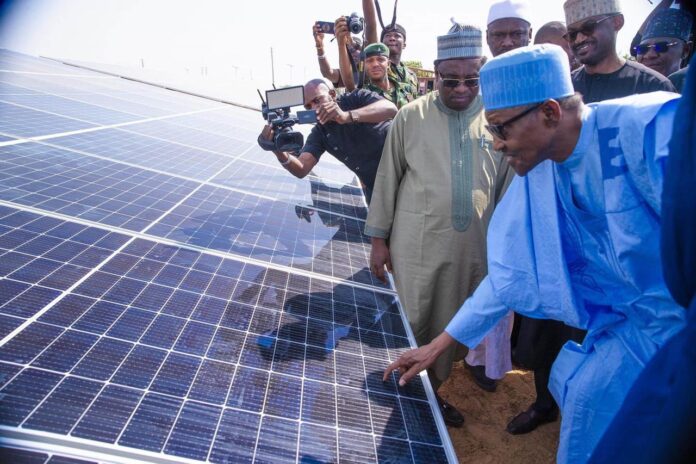By Musa Abdullahi Sufi
Nigeria’s power sector has long been a barrier to economic growth and development. From unreliable electricity supply to poor infrastructure, the challenges have affected industries, small businesses, and the daily lives of citizens.
Recognizing the need for reform, former President Muhammadu Buhari’s administration introduced several initiatives, investments, and partnerships aimed at improving generation, transmission, and distribution across the country.
This article is an attempt to highlights Buhari’s approach to tackling power challenges nationwide and the resulting impact, with examples of projects in places like Kano State where I know better. Among these success are listed and briefly explains below.
Expansion of Generation Capacity through Power Projects
Buhari’s administration launched and revitalized several power plants and projects that increased Nigeria’s generation capacity. These included Zungeru Hydroelectric Power Plant with 700MW project located in Niger State aimed at improving the energy mix with renewable hydropower.
Others include Kashimbila Hydropower Plant providing 40MW plant also addressed environmental risks by managing excess water flow from the dam and Afam III Fast Power Plant adding 240MW of power to the national grid, the plant was part of a strategy to revamp power infrastructure inherited from previous administrations.
Through these projects, Nigeria’s total installed power generation capacity reached over 13,000 MW by the end of Buhari’s tenure, though operational capacity remains limited due to transmission and distribution issues.
Strengthening Transmission Infrastructure: Stabilizing the Grid
Buhari’s administration identified the need to overhaul the Transmission Company of Nigeria (TCN) and build new substations to ensure generated power could reach consumers.
One of the landmark achievements was the National Grid Expansion Plan. This plan has the following key components:
One is Kano 330/132KV Rimin Zakara Substation: This substation stabilized electricity supply in Kano and nearby states, allowing more industries to connect to the national grid.
Secondly is Kano-Kaduna Transmission Line Upgrade that is Part of a broader strategy to increase the capacity of power corridors linking the North to other parts of Nigeria.
Thirdly is the Lagos to Ogun Transmission Lines focus on Reinforcing power delivery to the southwest region, supporting industrial hubs and residential consumers.
The administration’s Transmission Rehabilitation and Expansion Program (TREP), supported by international funding partners like the World Bank and African Development Bank, enabled the construction of new transmission lines and enhanced the reliability of the grid.
Siemens-Nigeria Power Project: A Comprehensive Reform Plan
A flagship project of Buhari’s administration was the partnership with Siemens Energy, a German company, under the Presidential Power Initiative (PPI). The goal of the project was to Address bottlenecks in electricity generation, transmission, and distribution, Upgrade critical infrastructure to provide 25,000MW of electricity by 2025 through a phased approach and Provide modern equipment like transformers and switchgear for Nigeria’s transmission network.
This initiative marked a shift towards long-term reform, focusing on technical upgrades, capacity building, and reducing losses in power distribution.
Promoting Renewable Energy and Rural Electrification
Buhari’s administration also prioritized renewable energy, launching the Solar Power Naija initiative to provide off-grid solar solutions for rural and underserved communities. These efforts included the deployment of mini-grids and solar home systems in partnership with the Rural Electrification Agency (REA), solar projects targeting 5 million households, impacting over 25 million people, particularly in off-grid communities and solar electrification of 200 primary healthcare centers and public facilities across states to enhance service delivery.
These renewable energy initiatives not only improved access to electricity but also reduced dependence on diesel generators, cutting costs for businesses and public institutions.
Addressing Power Distribution Challenges
The privatization of the Distribution Companies (DisCos) in 2013 left unresolved challenges, such as poor customer service, inadequate metering, and financial sustainability. Buhari’s administration took steps to address these issues.
One of the approach was the introduction of the National Mass Metering Program (NMMP), which distributed over 1 million prepaid meters to reduce estimated billing and improve transparency. Also, increasing regulatory oversight through the Nigerian Electricity Regulatory Commission (NERC) to ensure accountability and reduce tariff disputes. And providing financial support to DisCos through Central Bank interventions to stabilize operations and encourage investments.
These reforms reduced power theft, increased billing efficiency, and gradually improved revenue collection for the sector.
Impact and Results of Buhari’s Power Reforms
The power initiatives implemented under Buhari’s administration resulted in several positive outcomes. Some of the impacts include improved electricity supply to critical sectors, including healthcare, education, and industries
In addition is the stabilization of power in industrial areas like Kano, where agro-industries and manufacturing businesses reported fewer disruptions, increasing productivity and employment.
Similar, expansion of solar power programs that benefitted small businesses and rural households, improving economic activities in off-grid areas also reported. An the was encouraged foreign direct investment (FDI) into the energy sector due to clearer policy direction and infrastructure upgrades, particularly with the Siemens project.
However, challenges such as vandalism, energy theft, and operational inefficiencies in the DisCos persisted, limiting the full impact of these reforms. Nevertheless, Buhari’s efforts laid a strong foundation for future administrations to build on and further improve the sector.
Conclusion: Laying the Groundwork for a Brighter Future
The Buhari administration took significant steps to address Nigeria’s power challenges through a combination of infrastructure investments, private sector collaboration, and regulatory reforms. While power shortages remain a pressing issue, Buhari’s tenure saw key improvements in grid stability, rural electrification, and policy frameworks that are critical for long-term success.
With ongoing projects like the Siemens Presidential Power Initiative and the expansion of transmission lines, there is hope that Nigeria will achieve sustainable power delivery in the near future, unlocking economic potential across the country.
His administration’s focus on power generation and regional projects like the Rimin Zakara substation in Kano provides a model for how infrastructure can drive development, empower industries, and improve the quality of life for Nigerians.
The reforms may not have solved all power challenges, but they represent a solid step forward in Nigeria’s journey toward uninterrupted electricity and energy security.




